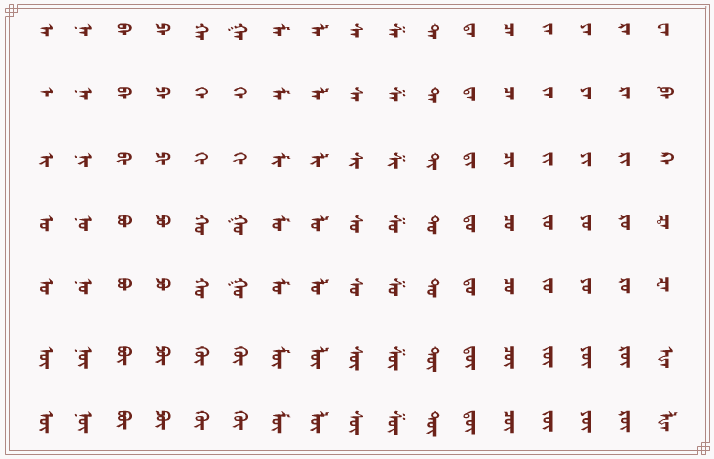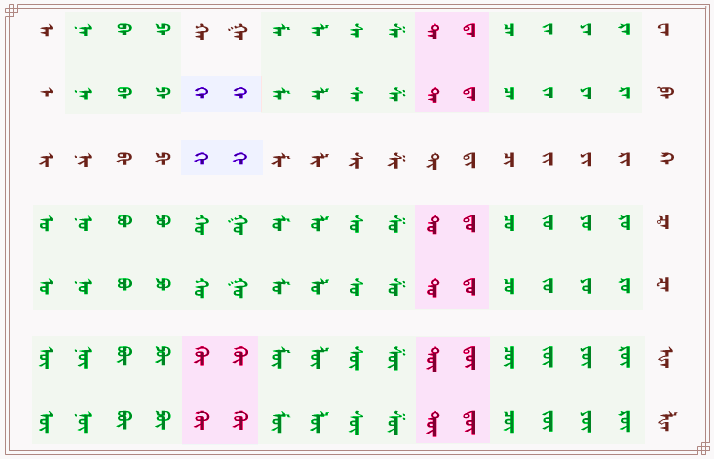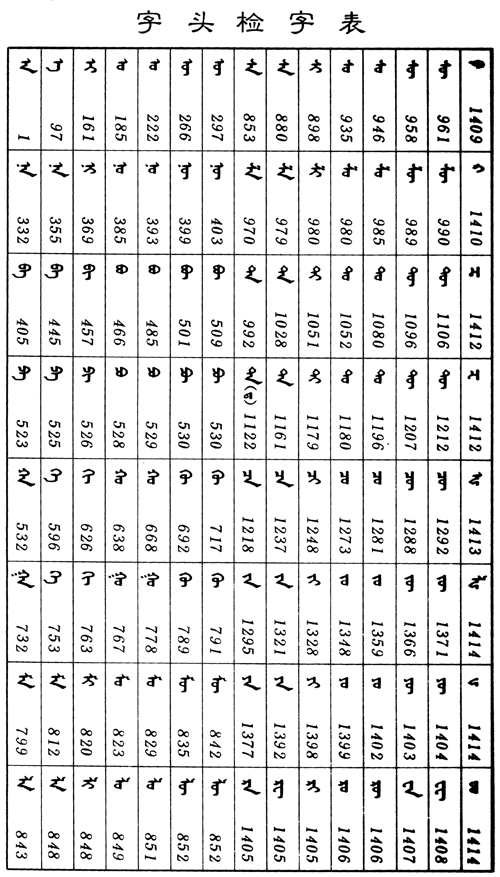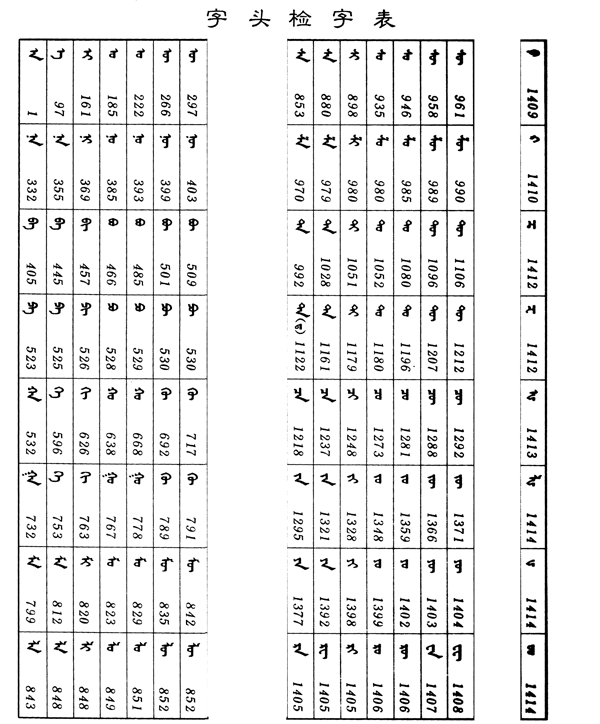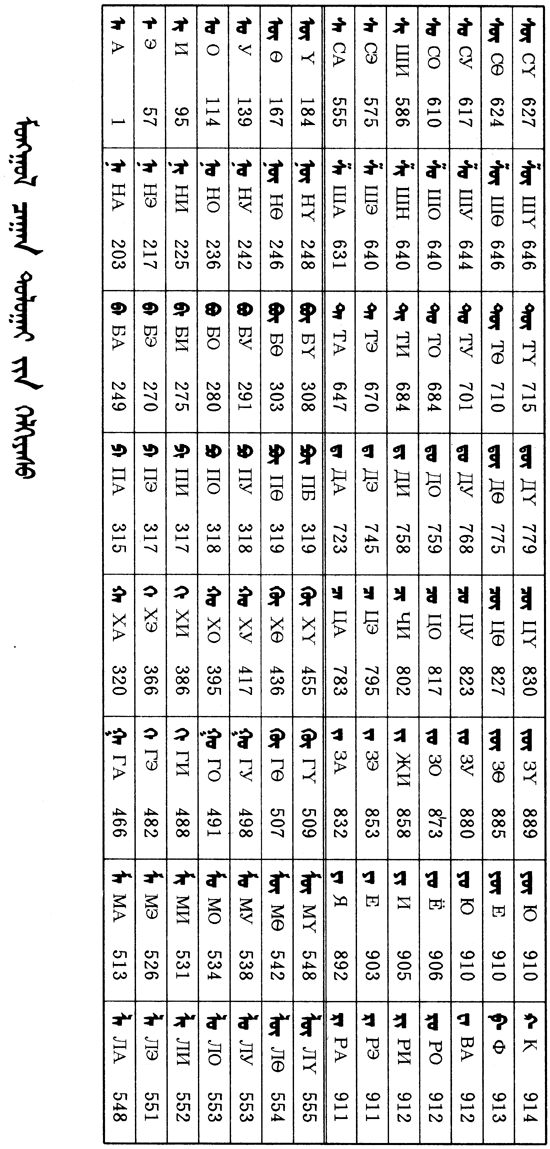Looking up dictionaries in the Traditional Mongolian alphabet (Inner Mongolia)
This article is about looking up modern Inner Mongolian dictionaries arranged according to the traditional script. To be precise, it's based on the following dictionaries:
Looking up words in the Mongolian traditional alphabet is quite different from looking up words in English dictionaries. For English, you just need to know the order of the letters of the alphabet and you can find any word (except inflected forms) purely from its spelling.
This approach does not work with Inner Mongolian dictionaries. Dictionaries in the traditional alphabet assume you know how the traditional script is taught in schools. In particular, you need to know the traditional written pronunciation (as opposed to the modern spoken pronunciation) of the word.
PRINCIPLES
The basic principles in understanding the system are:
1. Whereas English dictionaries are split up according to the letters of the alphabet, based on the first letter of each word (starting with the letter A, the letter B, etc., right down to the letter Z), Mongolian dictionaries are divided up according to the first syllable of the word.
2. The order of syllables used is that taught in the school system (see Making sense of the Traditional Mongolian Script), which arranges syllables in a table. Since Mongolian letters may have more than one pronunciation, syllables that are written identically but pronounced differently are kept separate in the syllable tables.
Accordingly, in Mongolian dictionaries, words that have initial syllables that are written identically but pronounced differently are assigned to different sections of the dictionary.
3. As a result, looking up words for which the (traditional) pronunciation is unknown can involve looking through two, or possibly four different sections of the dictionary.
4. Within each section, the arrangement is again according to the correct order of syllables and letters. However, note that:
a. At the end of a word, closed syllables (syllables that end in non-syllabic consonants) precede open syllables. Inside a word, closed syllables follow open syllables.
b. Vowel-lengthening letters or diphthongs (open syllables) follow their normal ordering as vowels.
INDEX OF SYLLABLES
The following table is the index to the Mongolian-language dictionary at miniovoo.net and demonstrates the standard order used in Inner Mongolia. (The table is in the printed form of the alphabet. For conversion between printed and handwritten forms, see Conversion tables).
The table is to be read from top to bottom, starting at the top left hand corner and working to the right.
The first column (at the left) lists vowels as they are found at the start of words. Using the modern Inner Mongolian sounds (in IPA), the Cyrillic alphabet, and conventional romanisatiions, the order is:
IPA: a, e, i, ɔ, ʊ, o, u
Cyrillic: а, э, и, о, у, ө, ү
Conventional romanisation: a, e, i, o, u, ö, ü
Subsequent columns list syllables beginning with consonants, in the order:
IPA: n, b, p, x, g / ɣ, m, l, s, ʃ, t, d, tʃ, dʒ, j, r
Cyrillic: н, б, п, х, г, м, л, с, ш, т, д, ч/ц, ж/з, й, р (note that some classical consonants have split in two, represented as ч/ц, ж/з in Cyrillic).
Conventional romanisations: n, b, p, h (or kh), g, m, l, s, š (or sh), t, d, č (or ch), ǧ (or j), y, r
The final column (on the right) shows letters used in foreign words: va, fa, ka, tsa, dza, xa, lxa (Cyrillic ва, фа, ка, ца, за, ха, лха).
This order is not at all clear from looking at the traditional alphabetic index. Converted into IPA and Cyrillic, the table is as follows, first in IPA (representing modern Inner Mongolian pronunciations of syllables):
| a |
na |
ba |
pa |
xa |
ɣa |
ma |
la |
sa |
ʃa |
ta |
da |
tʃa |
dʒa |
ja |
ra |
va |
| ə |
nə |
bə |
pə |
xə |
gə |
mə |
lə |
sə |
ʃə |
tə |
də |
tʃə |
dʒə |
jə |
rə |
fa |
| i |
ni |
bi |
pi |
xi |
gi |
mi |
li |
si |
ʃi |
ti |
di |
tʃi |
dʒi |
ji |
ri |
ka |
| ɔ |
nɔ |
bɔ |
pɔ |
xɔ |
ɣɔ |
mɔ |
lɔ |
sɔ |
ʃɔ |
tɔ |
dɔ |
tʃɔ |
dʒɔ |
jɔ |
rɔ |
tsa |
| ʊ |
nʊ |
bʊ |
pʊ |
xʊ |
ɣʊ |
mʊ |
lʊ |
sʊ |
ʃʊ |
tʊ |
dʊ |
tʃʊ |
dʒʊ |
jʊ |
rʊ |
dza |
| o |
no |
bo |
po |
xo |
go |
mo |
lo |
so |
ʃo |
to |
do |
tʃo |
dʒo |
jo |
ro |
xa |
| u |
nu |
bu |
pu |
xu |
gu |
mu |
lu |
su |
ʃu |
tu |
du |
tʃu |
dʒu |
ju |
ru |
lxa |
In Cyrillic, this becomes:
| а |
на |
ба |
па |
ха |
га |
ма |
ла |
са |
ша |
та |
да |
ча/ца |
жа/за |
я |
ра |
ва |
| э |
нэ |
бэ |
пэ |
хэ |
гэ |
мэ |
лэ |
сэ |
шэ |
тэ |
дэ |
чэ/цэ |
жэ/зэ |
е |
рэ |
фа |
| и |
ни |
би |
пи |
хи |
ги |
ми |
ли |
си |
ши |
ти |
ди |
чи/ци |
жи/зи |
и |
ри |
ка |
| о |
но |
бо |
по |
хо |
го |
мо |
ло |
со |
шо |
то |
до |
чо/цо |
жо/зо |
ё |
ро |
ца |
| у |
ну |
бу |
пу |
ху |
гу |
му |
лу |
су |
шу |
ту |
ду |
чу/цу |
жу/зу |
юу |
ру |
за |
| ө |
нө |
бө |
пө |
хө |
гө |
мө |
лө |
сө |
шө |
тө |
дө |
чө/цө |
жө/зө |
ю |
рө |
ха |
| ү |
нү |
бү |
пү |
хү |
гү |
мү |
лү |
сү |
шү |
тү |
дү |
чү/цү |
жү/зө |
юү |
рү |
лха |
If we convert the table into the romanisation used in 蒙汉词典/Cyrillic: Монгол Хятад Толь, the order is as follows:
| a |
na |
ba |
pa |
xa |
ɣa |
ma |
la |
sa |
ša |
ta |
da |
ča |
ǰa |
ya |
ra |
wa |
| e |
ne |
be |
pe |
xe |
ge |
me |
le |
se |
še |
te |
de |
če |
ǰe |
ye |
re |
fa |
| i |
ni |
bi |
pi |
xi |
gi |
mi |
li |
si |
ši |
ti |
di |
či |
ǰi |
yi |
ri |
ka |
| o |
no |
bo |
po |
xo |
ɣo |
mo |
lo |
so |
šo |
to |
do |
čo |
ǰo |
yo |
ro |
ca |
| u |
nu |
bu |
pu |
xu |
ɣu |
mu |
lu |
su |
šu |
tu |
du |
ču |
ǰu |
yu |
ru |
za |
| ö |
nö |
bö |
pö |
xö |
gö |
mö |
lö |
sö |
šö |
tö |
dö |
čö |
ǰö |
yö |
rö |
ha |
| ü |
nü |
bü |
pü |
xü |
gü |
mü |
lü |
sü |
šü |
tü |
dü |
čü |
ǰü |
yü |
rü |
lha |
(The large Монгол Хэлний Толь uses a slightly different romanisation in which ö and ü are rendered as ɵ and ʉ respectively. This dictionary also differs from others by placing the l column before the m column.)
Setting out the table in IPA, Cyrillic, and conventional romanisation shows very clearly the order followed by the dictionary. This order is not clear by looking solely at the traditional script because of ambiguity over the pronunciation of certain vowels and consonants, notably:
The vowel sets a and ə, ɔ and ʊ, and o and u are not systematically distinguished. (In Cyrillic this corresponds to а and э, о and у, and ө and ү. In conventional romanisations it corresponds to a and e, o and u, ö and ü).
The consonants x and g / ɣ (corresponding to Cyrillic х and г) are not distinguished before feminine/yin vowels.
The consonants t and d (т and д) are in practice almost never distinguished.
The index below indicates in graphic form those syllables that are ambiguous as to pronunciation. Syllables ambiguous between two vowels are shown in green; those ambiguous between two consonants are shown in blue; those ambiguous between both vowels and consonants (four possible readings) are shown in maroon.
In looking up a word, the user must mentally convert the syllable to its correct pronunciation in order to find the word in the dictionary. If the user does not know the correct pronunciation, he/she must be prepared to check the word in two or more different sections.
The situation is not, of course, quite as dire as it appears, since the a and ə (Cyrillic а and э) rows can often be distinguished if there is indication of vowel harmony in the word. But in many cases, without knowing the correct pronunciation, the user is condemned to looking through several different parts of the dictionary.
ROMANISED SPELLING
One feature of the 蒙汉词典/Cyrillic: Монгол Хятад Толь and the Монгол Хэлний Толь is the provision of a romanised form for each entry. This is given in a conventional romanised spelling. If a letter is meant to be interpreted as 'e', the romanised form spells it as 'e'. If a letter is meant to be 'a', the romanised form spells it as 'a'. This is extremely helpful as it reveals the form of the word used in ordering entries. While not help much in looking up words, it does reveal the correct interpretation of ambiguous traditional spellings.
For example, the entry is given in 蒙汉词典 with the romanisation dalai. This indicates that the word is interpreted as dalai in the traditional spelling. That is why it is found in the section for da. is given in 蒙汉词典 with the romanisation dalai. This indicates that the word is interpreted as dalai in the traditional spelling. That is why it is found in the section for da.
Additionally, this dictionary then gives the modern Inner Mongolian pronunciation for each entry using the IPA alphabet. In this case this is dalæ:.
The same form  is found at another location in the dictionary with a different meaning, with the romanisation telei. This indicates that this word is interpreted as telei in the traditional spelling, and is thus found in the section ta. The modern Inner Mongolian pronunciation is təli:. is found at another location in the dictionary with a different meaning, with the romanisation telei. This indicates that this word is interpreted as telei in the traditional spelling, and is thus found in the section ta. The modern Inner Mongolian pronunciation is təli:.
The use of two separately conceived romanisations, one for the traditional spelling, one for the modern Inner Mongolian pronunciation, can be confusing. To use a different example, the same word is represented as čöm for the traditional spelling and as ʧom for the modern Inner Mongolian pronunciation. While the system of romanisation is different, these represent virtually identical sounds.
Some dictionaries (Монгол Хэлний Товч Тайлбар Толь and Монгол Хэлний Толь) give the modern Cyrillic spelling of each entry.
EXAMPLES
The following are a few examples of what this method of organising the dictionary entails.
 is simple to look up because there is only one place to look, under is simple to look up because there is only one place to look, under  e (Cyrillic э). The second syllable is also a simple e (Cyrillic э). The second syllable is also a simple  . The meaning is 'mother' (Chinese 妈 mā), modern pronunciation ə:dʒ. . The meaning is 'mother' (Chinese 妈 mā), modern pronunciation ə:dʒ. |
 |
 must be checked at two places, bo and bu (Cyrillic бо and бу). Both are written must be checked at two places, bo and bu (Cyrillic бо and бу). Both are written  . Upon checking both we will find that only one of these actually exists, with the traditional pronunciation buɣu (NOT boɣu). The meaning is 'deer' (Chinese 鹿 lù), dictionary entry shown at right. . Upon checking both we will find that only one of these actually exists, with the traditional pronunciation buɣu (NOT boɣu). The meaning is 'deer' (Chinese 鹿 lù), dictionary entry shown at right. |
 |
 must also be checked at two places, xo and xu (Cyrillic хо and ху, other traditional romanisations ho and hu or kho and khu). Both are written must also be checked at two places, xo and xu (Cyrillic хо and ху, other traditional romanisations ho and hu or kho and khu). Both are written  . Upon checking we will find a word with this spelling at both places. As xola it means 'far'; as xula it means 'yellowish-brown, fawn'. The modern pronunciations are xɔl and xʊl (Cyrillic хол and хул) respectively. The two dictionary definitions are shown at right (Chinese 远 yuǎn 'far', 金黄毛 jīnhuángmáo 'golden-yellow hair (of horse)'). . Upon checking we will find a word with this spelling at both places. As xola it means 'far'; as xula it means 'yellowish-brown, fawn'. The modern pronunciations are xɔl and xʊl (Cyrillic хол and хул) respectively. The two dictionary definitions are shown at right (Chinese 远 yuǎn 'far', 金黄毛 jīnhuángmáo 'golden-yellow hair (of horse)'). |
  |
 must be checked at four places, under ta, te, da, and de (Cyrillic та, тэ, да, дэ). All are normally written must be checked at four places, under ta, te, da, and de (Cyrillic та, тэ, да, дэ). All are normally written  . Upon checking all four, we will find two words that are spelt this way: dalai ('sea') and telei ('waist-cord, belt'). In their modern pronunciation they are dalæ: and təli: (далай and тэлий) respectively. Dictionary entries are shown at right (Chinese 海 hǎi 'sea' and 裤带 kùdài 'trouser-cord' respectively). . Upon checking all four, we will find two words that are spelt this way: dalai ('sea') and telei ('waist-cord, belt'). In their modern pronunciation they are dalæ: and təli: (далай and тэлий) respectively. Dictionary entries are shown at right (Chinese 海 hǎi 'sea' and 裤带 kùdài 'trouser-cord' respectively). |
  |
NON-SYLLABIC LETTERS
As mentioned above, inside the dictionary non-syllabic consonants (those used to end a syllable) follow a particular order. Word-ending consonants are listed first, then consonants followed by vowels (i.e., those that form syllables), and finally syllable-ending consonants (those that are followed by another consonant). Taking the section  dʒo (Cyrillic жо) as an example, we look at the consonant r (using selected entries only): dʒo (Cyrillic жо) as an example, we look at the consonant r (using selected entries only):
 r in word-final position r in word-final position |

ǰor |
The consonant  r ends the word and is not syllabic (i.e., not followed by a vowel). This is therefore the first entry. r ends the word and is not syllabic (i.e., not followed by a vowel). This is therefore the first entry. |
'Fortune, good luck'
modern Cyrillic зор;
also 'medical dispensary' modern Cyrillic жор. |
 ri ri |

ǰori |
The consonant  r is followed by the final vowel r is followed by the final vowel  i. i. |
'Target', modern Cyrillic зорь (sometimes seen but not listed in dictionaries). |

ǰorixu |
 ri is followed by the open syllable ri is followed by the open syllable  xu (consonant followed by vowel). xu (consonant followed by vowel). |
'To strive, to aim for', modern Cyrillic зорих. |

ǰoriɣ |
 ri is followed by the word-ending consonant ri is followed by the word-ending consonant  ɣ (ɣ follows x in Mongolian alphabetic order). ɣ (ɣ follows x in Mongolian alphabetic order). |
'Bravery', modern Cyrillic зориг. |

ǰoriɣulxu |
 ri is followed by the syllable ri is followed by the syllable  ɣu (consonant plus vowel). ɣu (consonant plus vowel). |
'To dedicate, to do sth for', modern Cyrillic зориулах. |

ǰoriɣtai |
 ri is followed by the syllable-final consonant ri is followed by the syllable-final consonant  ɣ within the word (consonant plus consonant). ɣ within the word (consonant plus consonant). |
'To be brave', modern Cyrillic зоригтой. |
 ro ro |

ǰoro |
The consonant  r is followed by the final vowel r is followed by the final vowel  o. o. |
Part of expression meaning 'be arrogant, overbearing'. Modern Cyrillic зор. |

ǰoroxon |
 ro is followed by the syllable ro is followed by the syllable  xon. xon. |
Part of expression referring to 'wren', in modern Cyrillic зорхон. |
 r plus consonant r plus consonant |

ǰorxu |
 r is followed by the syllable r is followed by the syllable  xu. xu. |
'Whittle, plane', modern Cyrillic зорох. |
 ǰorlong ǰorlong |
 r is followed by the syllable r is followed by the syllable  long. long. |
'Toilet', modern Cyrillic жорлон. |
 ǰortai ǰortai |
 r is followed by the syllable r is followed by the syllable  tai. tai. |
'Lucky', modern Cyrillic зортой'. |

ǰortʃixu |
 r is followed by the syllable r is followed by the syllable  tʃi. tʃi. |
'Go back and forth, travel, totter (infant's steps)', modern Cyrillic зорчих. |
The examples at  ri show this principle in action for ri show this principle in action for  ɣ / ɣ /  ɣu / ɣu /  ɣ. The same applies to other letters. ɣ. The same applies to other letters.
At the n series, note that syllable-final  ng precedes syllable-final ng precedes syllable-final  n (similarly for word-final forms). n (similarly for word-final forms).
DIFFICULTIES OF USING THE TABLES...
The decision to split entries not purely according to spelling but according to the traditional pronunciation of the syllable makes using a Mongolian dictionary much less convenient than it should be. But your travails will be needlessly aggravated by the way the index is set out in the endpapers in the 蒙汉词典 / Монгол Хятад Толь. This is the list of syllables (sections) in the dictionary, an arrangement which is guaranteed to make the eyes glaze over. (Note: this table uses citation forms of the syllables, unlike the minivoo.net dictionary).
The table actually consists of three parts, as shown below. Once the table is split up it becomes more usable.
The Монгол Хэлний Товч Тайлбар Толь does a somewhat better job (although with errors):
|
